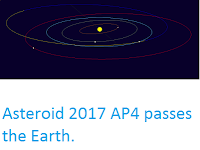Asteroid (265482) 2005 EE passed by the Earth at a distance of about 10 240 000
km (26.6 times the average distance between the Earth and the Moon, or
6.84% of the distance between the Earth and the Sun), slightly before 6.25 am
GMT on Sunday 15 January 2017. There was no danger of
the asteroid hitting us, though were it to do so it would have
presented a considerable threat. ((265482) 2005 EE has an estimated
equivalent
diameter of 110-360 m (i.e. it is estimated that a spherical object with
the same volume would be 110-330 m in diameter), and an object of this
size would be predicted to be capable of passing through the Earth's
atmosphere relatively intact, impacting the ground directly with an
explosion that would be 600-110 000 times as powerful as the Hiroshima
bomb. Such an impact would result in an impact crater 1.5-5 km in
diameter
and devastation on a global scale, as well as climatic effects that
would last decades or even centuries.
The calculated orbit of (265482) 2005 EE. Minor Planet Center.
(265482) 2005 EE was discovered on 1 March 2005 by the University of Arizona's Catalina Sky Survey,
which is located in the Catalina Mountains north of Tucson. The
designation 2005 EE implies that it was the fifth asteroid (asteroid E)
discovered in the first half of March 2005 (period 2005 E), while the longer designation (265482) indicates that it was the 265 482nd asteroid discovered
overall (asteroids are not given this longer designation immediately, to
ensure that numbered objects are genuine asteroids that have not been
previously described).
(265482) 2005 EE is calculated to have a 438 day orbital
period and an elliptical orbit tilted at an angle of 6.17° to the plain of the
Solar System that takes it from 0.76 AU from the Sun (i.e. 76% of the average
distance at which the Earth orbits the Sun, slightly outside the orbit of Venus) to 1.50 AU from the Sun (i.e. 150%
of the average distance at which the Earth orbits the Sun, roughly the
distance at which the planet Mars orbits the Sun). It is therefore classed as
an Apollo Group Asteroid (an asteroid that is on average further from the Sun
than the Earth, but which does get closer). This means that close encounters between the
asteroid and Earth are extremely common, with the last having occurred
in May 2016 and the next predicted in July 2021. (265482) 2005 EE also has frequent close encounters with the
planet Venus, with the last calculated to have happened in April 2013 and the next predicted for February 2036. As
an asteroid possibly larger than 150 m in diameter that occasionally
comes within 0.05 AU of the Earth, (265482) 2005 EE is also classified
as a Potentially Hazardous Asteroid.
See also...







